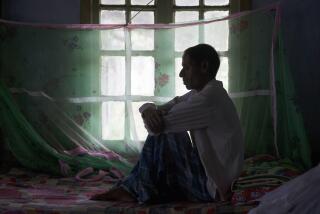California Trails U.S. Cancer Rate : Health: A survey shows 10% fewer new cases in the state than in the nation as a whole. L.A. County has the lowest figures statewide.
- Share via
Cancer rates in California vary somewhat from region to region, but experts caution that many of the differences are likely to be explained by known cancer risk factors, including smoking habits and ethnic and racial background.
Preliminary results of the state Department of Health Services’ 1988 cancer survey, released Tuesday, show that the overall rate of new cancers in the state is about 10% lower than in the nation as a whole. The 1988 survey is the first to cover all areas of the state.
There is a cancer case diagnosed in California every five minutes and about 130 deaths from cancer each day, according to Dr. Kenneth W. Kizer, the state health director.
The 1987 preliminary findings were publicized last month. In both years, the cancer rates for Los Angeles County were the lowest in the state, while those for the San Francisco Bay Area, the Inland Empire, Orange County and San Diego were higher.
John L. Young Jr., the principal author of the report, said these differences “most assuredly” reflect the ethnic mix of the population as well as the impact of AIDS-related cancers on San Francisco. Although San Francisco and Los Angeles both have large numbers of AIDS cases, such individuals represent a higher proportion of the population in San Francisco.
“Los Angeles County appears to have low cancer rates because it has more Asians and Latinos than other counties,” said Leslie Bernstein of the USC-Los Angeles County cancer surveillance program. “The cancer rates of Asians and Latinos are known to be 30% to 40% lower than those of blacks and whites.
“When one area is compared to another area, the first impulse is to look for environmental extrapolations,” Bernstein said in a statement. “But it’s a mistake to assume from the present data that it’s safer to live in Los Angeles than in the San Francisco Bay Area. The relative rates for whites, for example, will be very similar.”
The surveys are likely to prove valuable for public health officials who track unusual patterns of cancer cases, such as the apparent cluster of childhood cancer cases during the 1980s in McFarland and other San Joaquin Valley towns. But officials said the data so far provide no evidence that exposure to pollution or other environmental factors can explain the variations between the state and the nation or between regions of the state.
The results may also bolster public health campaigns against well-known cancer risk factors, such as cigarette smoking.
The cancer rate in Los Angeles County was 314 cases per 100,000 population in 1988, according to the state. The rate for the San Francisco Bay Area was 369 per 100,000. The statewide average rate was 341 per 100,000.
The results in the reports are adjusted for age and sex variations. Although state officials believe that variations in the racial and ethnic composition of the population explain many of the regional differences in cancer rates, they have yet to perform detailed analyses to show that this is the case. Such analyses are likely to be done after racial and ethnic data from the 1990 census becomes available.
In 1988, lung cancer was the leading cause of cancer deaths among both men and women in the state. About 90% of lung cancer cases are directly related to cigarette smoking, Young said.
Prostate cancer was the most frequently diagnosed malignancy among men. Breast cancer was the most frequently diagnosed tumor among women. In both sexes, colorectal cancer was the third-most frequently diagnosed malignancy and the third-leading cause of cancer deaths.
In another finding, the report found that men in San Diego County had a particularly high rate of prostate cancer, 105 cases per 100,000. By comparison, men in Los Angeles County had a low rate, 75 cases per 100,000. The statewide average rate was 87 cases per 100,000 men.
Kizer said these differences might reflect the relatively large number of male military retirees in San Diego County and underscored the importance of regular rectal exams and other screening tests for prostate cancer.
In men, there were 50,949 new cancer cases in California in 1988 and 24,578 deaths. In women, there were 52,465 new cancer cases and 22,803 deaths.
Since 1985, it has been mandatory to report cancer cases in California. In 1988, the California tumor registry was expanded to cover the entire population of California through 10 regional registries. Previously, detailed cancer data had only been compiled for parts of the state, such as Los Angeles County, Orange County and the San Francisco Bay Area.
“We now have in place the largest cancer registry . . . in the world,” Kizer said.
CANCER IN CALIFORNIA
The state Department of Health Services has released a preliminary report on cancer cases and deaths in California in 1988. These are the leading types of cancer in the state for men and women, according to the report.
The statistics are age-adjusted annual rates per 100,000 people. Figures are rounded off. MEN
Cancer Cases
Total: 386
Of that total . . . Prostate: 87
Lung: 73
Colorectal: 51
Cancer Deaths
Total: 191
Of that total . . . Lung: 60
Prostate: 23
Colorectal: 20
WOMEN
Cancer Cases
Total: 316
Of that total . . . Breast: 101
Lung: 40
Colorectal: 35
Cancer Deaths
Total: 133
Of that total . . . Lung: 30
Breast: 25
Colorectal: 14
More to Read
Sign up for Essential California
The most important California stories and recommendations in your inbox every morning.
You may occasionally receive promotional content from the Los Angeles Times.













